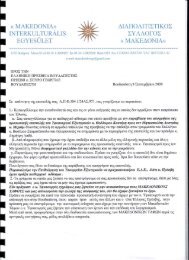Görög Örökség Ελληνική Κληρονομιά - H-ellin.com
Görög Örökség Ελληνική Κληρονομιά - H-ellin.com
Görög Örökség Ελληνική Κληρονομιά - H-ellin.com
You also want an ePaper? Increase the reach of your titles
YUMPU automatically turns print PDFs into web optimized ePapers that Google loves.
people of Gyor at that time was living in the same street were the church was. Some old houses have been<br />
preserved until now. Concerning the profession, the Greeks of Gyor were mainly tanners and cereals-traders.<br />
The latter were also called "burcsellas" ("burcsellas" in Hungarian was the name of the boat which transported<br />
the cereals.]. We have already mentioned the Greek influence in the decoration of the temple. This opinion is<br />
based also on the fact that in 1770 a greek-speaking school was operating in the area. However, in 1801 the<br />
school book of religion written for the orthodox youth of Gyor was published in Hungarian which is indicative<br />
of a peaceful coexistence. From the temple of Gyor, two icons of Theotokos were transferred to the Museum<br />
of Serbian Church Art of Szentendre. The one with an oldenslavic inscription denotes that in the 1Τ century<br />
the icon belonged to the leader Peter Monaszterly. ( Monaszterly acted as the leader of the Serbian seamen of<br />
Komarom). The other one with obvious Italian influence dates also back to the 1Τ century. The icon<br />
"Theotokos (the Mother of God) the undying Rose" or else, " Theotokos with flowers" is decorated with<br />
motives of roses, other flowers and figures of saints. The orthodox church <strong>com</strong>munity of Gyor was until the<br />
recent times registered in the Episcopate of Buda. They respected the destiny of the other serbian-greek<br />
<strong>com</strong>munities which was isolation: in 1874 the orthodox <strong>com</strong>munity consisted of only 15 members.<br />
During the 60s in general once a year they had the mass in the Holly Temple dedicated to Agios Nikolaos (the<br />
mass was attended not so much by the orthodox believers but by some of the neighborhood residents). The<br />
works for the restoration of the baroque temple started and for this reason the icons of the shrine were moved<br />
elsewhere. At the beginning of 1990, the greek-catholic church <strong>com</strong>munity was established. A few years ago,<br />
they were given the right to use the so-called temple, which belongs to the Serbs, with greek decoration. In the<br />
old clergy (in the yard of which exists the temple) began its operation the <strong>com</strong>mune hall of the greek-catholic<br />
church <strong>com</strong>munity.<br />
Miskolc<br />
Of all the cities in northern Hungary, Miskolc is were a considerable <strong>com</strong>munity of Greek traders was formed,<br />
during the 18 1 century. Its members took active role in the urbanization of the city. A solid proof of their<br />
extensive business relations lies on the fact that they expanded abroad, mainly Poland, other than the<br />
Hungarian cities. We are fortunate enough to have at our disposal numerous historic documents concerning<br />
them and we can make a detailed reconstruction of their lives and their activities. Above all we can also check<br />
the lives of Greeks living in other cities: on the one hand by using the method of analogy which is feasible due<br />
to similar circumstances and on the other hand with the aid of specific business and family records. This is<br />
particularly important because there are cities in which any document referring to Greek traders became<br />
fragmentary during the years ( for instance in the case of Gyöngyös). The history of the Greeks of Miskolc<br />
gives us the chance to create the frame of the <strong>com</strong>munities of the Greek traders in Hungary.<br />
When did the Greeks appear in Miskolc? Based on István Dobrossy the first evidence dates back in 1668(from<br />
the protocol of the city of Miskolc): " The same year a man named János Tokaji Németi, a trader from Tokaj<br />
... the honorable Board permitted him the right to set up a tent in the feast.". However, this extract does not<br />
make it perfectly clear if this is a Greek trader. A lot more precise is the list of taxpayers since 1692 in which a<br />
trader with the name of Daniel Gorog appears. A very important and early evidence is a seal of the Greek<br />
<strong>com</strong>pany of Miskolc in which the date 168 7 can be read.<br />
In the documents which include the transactions of Sándor Karácsony, member of the most eminent family of<br />
traders in the 18' century, the name of Marton Racz, a Greek trader from Miskolc appears. There is a document<br />
in which Racz is referred to as " Greek with belongings" ( probably meaning that he owned property, a home,<br />
a shop) which offers guarantee. In the above mentioned legal act of 1705 his partners were two more Greek<br />
traders, one from Nagykoros and the other from Debrecen. A question is posed: weren't there any other Greek<br />
guarantors in Miskolc? Amongst the documents concerning Sándor Karácsony there is a protocol from<br />
Debrecen of 1711 in which are mentioned a lot of Greek traders from Tokaj, Eger, Gyöngyös, Kecskemet and<br />
Nagykoros but nobody from Miskolc 1 . It is, therefore presumed, that the number of the greek church<br />
<strong>com</strong>munities of Miskolc multiplied mainly during the period after Rakoczi's war for freedom. Thus it is<br />
considered to be of great value the first volume of the registrar's office's books concerning the greek-orthodox<br />
<strong>com</strong>munity of Miskolc. This source includes weddings(those which did not happen in Miskolc between 1728<br />
and 1783 and those which<br />
66




